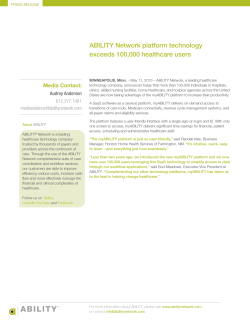
Full Text - European Journal of Public Health
European Journal of Public Health, Vol. 25, No. 3, 364–365 ß The Author 2015. Published by Oxford University Press on behalf of the European Public Health Association. This is an Open Access article distributed under the terms of the Creative Commons Attribution License (http://creativecommons.org/ licenses/by/4.0/), which permits unrestricted reuse, distribution, and reproduction in any medium, provided the original work is properly cited. ......................................................................................................... Viewpoints ......................................................................................................... The attack on universal health coverage in Europe: recession, austerity and unmet needs More than 1.5 million extra people have unmet need for healthcare since the beginning of the economic crisis in Europe. The advent of the Great Recession has placed Europe’s health systems under severe pressure, with real terms cuts to funding in many countries.1 Accounts in the peer-reviewed literature and popular media have catalogued examples of vulnerable groups and individuals unable to access necessary care.2 Although there have been case-studies of Spain, Greece and other individual nations,3 to our knowledge there has been no systematic attempt to quantify changes in unmet need for medical care across the European Union. Here, using data from the EU-wide Statistics of Income and Living Conditions (EU-SILC), we quantify the increase in self-reported unmet need, a comparative measure of healthcare access defined as being unable to obtain care when people believed it to be medically necessary, in association with the Great Recession.4 From 2005 to 2008, prior to the Great Recession, the proportion of the EU population (a population-weighted average of individual national figures) reporting unmet need was falling, as shown in the figure 1. Between 2005 and 2008 self-reported unmet medical need fell by 2% points, from 5 to 3.1%. Then, coinciding with the onset of the recession in 2008, this trend reversed, to rise through the period of austerity in Europe, to reach 3.4% in 2012, the latest year for which data are available. Using time-series discontinuity regression models, we then quantified the consequences of this reversal. In the years leading up to the Great Recession the prevalence of unmet medical need was falling at 0.4% points (95% CI: 0.16 to 0.58) each year (Table 1). After 2010, when austerity was implemented, unmet medical need began to rise in many countries, with an overall increase across the EU of 1.23% points (95% CI: 0.12 to 2.34) each year. These small percentage changes translate into a substantial population impact. In 2011, there were 502.5 million people in the EU. Taking the most conservative scenario, if we assume that the earlier decline in unmet need would simply have plateaued after 2010, then by 2011–12 the observed increase would represent an additional 1.5 million people who failed to obtain care they considered medically necessary. If, as is arguably more plausible, the previous decline had continued, then the difference would be even greater, totalling 7.3 million people. This overall trend conceals national differences and not all countries experienced worsening access to healthcare. In Sweden, during the crisis period between 2007 and 2012, unmet medical need fell by 1.8% points, whereas in Belgium, in contrast, it rose by 1.7% points across this same period. Rising unmet needs also appeared concentrated in deprived groups. Again, taking the most conservative scenario, we found that an additional 100 000 people experienced unmet medical need in the highest income quintile (population-weighted average across each country) while an additional 600 000 people in the poorest groups were unable to access care they considered medically necessary, a 6-fold larger increase. A continuation of this trend would further widen inequalities in healthcare access in Europe. The critical question for future research is what is reducing access to healthcare in some places but not in others? One hypothesis is that rising co-payments, which have expanded the cost of pharmaceuticals, outpatient care and A&E visits in some countries, are creating barriers to healthcare access in Europe. Despite clear evidence that such charges reduce both necessary and unnecessary utilization of care,5 they have been extended and expanded in the Czech Republic (2011), France (2010), Italy (2011), Latvia (2009), the Netherlands (2010) and Romania (2011), a process that has continued subsequently, as in Spain (2013). In contrast, nations that have reduced user fees, such as Croatia in 2011, have experienced declines in unmet medical need.3 Another hypothesis is that cost-saving reforms have reduced access to care. Cuts to healthcare services, involving closure of facilities (e.g. in Greece), reduced opening hours, and shrinking numbers of healthcare personnel can also worsen access to care.6,7 Several policy charges outside the health sector, such as reduced affordability of transport, might create further financial barriers to access. In practice, it is likely to be a combination of factors, with the balance varying among countries. Thus, all of these factors combine in Greece, which may explain the marked increase in unmet medical need; between 2007 and 2011 unmet medical need attributed to greater costs of care rose by 39%, whereas unmet medical need attributed to transport costs was 2.8 times higher in 2011 than in 2007. Finally, it is possible that recent policy reforms which restrict access of migrants and other vulnerable groups such as homeless persons and drug users, who tend to be under-represented in surveys, are taking a toll beyond what can be seen with EU-SILC data. In Spain, a royal decree in 2012 restricted access to the National Health Service for undocumented immigrants. The Czech Republic similarly has rewritten eligibility criteria to include only those who are permanent residents. In the UK, migrants from outside the European Economic Area will face additional costs to obtain healthcare services. By excluding certain groups from the social contract, states are undermining the principle of solidarity on which most European healthcare systems are based. Future targeted research is needed to investigate trends in unmet need among these high-risk groups. Irrespective of which reasons are most important, our observation of rising unmet need is a cause for concern. Many European nations have long benefited from universal access to care. Even though Europe’s recessions may be coming to an end, this promise remains under threat. Acknowledgements We would like to thank the reviewers for their helpful comments. Funding AR and DS are support by a Demetriq EU FP7 grant. This study was carried out with financial support from the Commission of the European Communities, grant agreement no. 278511. The study does not necessarily reflect the Commission’s views and in no way anticipates the Commission’s future policy in this area. DS is also funded by a Wellcome Trust Investigator Award. Conflicts of interest: None declared. Bailouts, austerity and the erosion of health coverage in Southern Europe and Ireland 365 Figure 1 Observed and predicted unmet medical need across EU, 2005–12. Notes: Source: Eurostat Table 1 Time trend analysis of 27 EU countries, 2005–12 4 Allin S, Masseria C. Unmet need as an indicator of health care access. EuroHealth 2009;15:7–9. Covariate Proportion of people with unmet medical need (95% CI) 5 Newhouse JP.Group RCIE. Free for All? Lessons from the RAND Health Insurance Experiment. Cambridge, MA.: Harvard University Press, 1993. Annual trend, 2005–10 Estimated excess unmet need during austerity, 2011–12 0.37% points ( 0.16 to 0.58) 1.23% points (0.12 to 2.34) 6 Kentikelenis A, Karanikolos M, Papanicolas I, et al. Health effects of financial crisis: omens of a Greek tragedy. The Lancet 2011;378:1457–8. 7 Kentikelenis A, Karanikolos M, Reeves A, et al. Greece’s health crisis: from austerity to denialism. The Lancet 2014;383:748–53. Notes: Source: EuroStat. References 1 Reeves A, McKee M, Basu S, Stuckler D. The political economy of austerity and healthcare: cross-national analysis of expenditure changes in 27 European nations, 1995–2011. Health Policy 2013;115:1–8. 2 Daley S. Fiscal crisis takes toll on health of Greeks. New York Times 2011. 3 Thomson S, Figueras J, Evetovits T, et al. Economic crisis, health systems and health in Europe: impact and implications for policy. European Observatory on Health System and Policies. Copenhagen: WHO, 2014. Aaron Reeves1, Martin McKee2, David Stuckler1,2 1 Department of Sociology, University of Oxford, Oxford, UK 2 Department of Health Services Research and Policy, London School of Hygiene and Tropical Medicine, London, UK Correspondence: Aaron Reeves, Manor Road Building, Manor Road, Oxford, Oxfordshire, OX3 1UQ, UK, Tel: 44 (0) 1865 286177, e-mail: aaron.reeves@sociology.ox.ac.uk doi:10.1093/eurpub/ckv040 ......................................................................................................... European Journal of Public Health, Vol. 25, No. 3, 365–366 ß The Author 2015. Published by Oxford University Press on behalf of the European Public Health Association. All rights reserved. ......................................................................................................... Bailouts, austerity and the erosion of health coverage in Southern Europe and Ireland Since 2008, the onset of economic crises in Europe has resulted in profound social dislocations and steep rises in unemployment. At the same time, austerity measures and structural reforms have crippled the capacity of welfare states to effectively respond to heightened demands for their services. Yet, while these phenomena can be observed across Europe, five countries stand out: Greece, Ireland, Portugal and Cyprus were bailed out by the international community—comprising European institutions and the International Monetary Fund—in exchange for wide-ranging policy reforms, and Spain opted into a period of austerity. Here, I document how these policy responses affected health coverage and examine challenges ahead. Among the countries in crisis, Greece experienced the deepest economic downturn, with unemployment rising from 7.8% in 2008 to 27.5% in 2013. As health insurance there is tied to employment status, by 2014 >23% of the population (2.5 million) became uninsured.1 In addition, health budget cuts and revenueraising measures (increased co-payments and user fees) introduced as part of the country’s bailout furthered the inability to access or afford health services.2 In response to popular pressure, the government introduced two schemes to increase access, but both failed to live up their promise. First, a new health voucher scheme, introduced in 2013, was intended to provide a limited bundle of services to 230 000 people, yet, in the first 17 months of
© Copyright 2025










